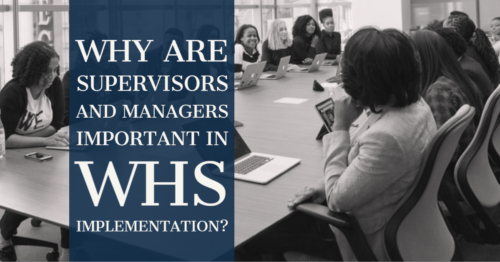The managers and supervisors play an important role in workplace health and safety, and training. After all, plans remain plans until they are carried out by trained and dedicated individuals. In any organisation, managers and supervisors can help the business achieve positive culture health safety. Since they are more in touch with ground operations, they can actively keep an eye out for unsafe practices and assist in activities that are prone to injuries.
How do managers and supervisors fulfill their responsibilities?
Supervisors are responsible for making sure work is done safely, even if they aren’t officially recognised as such.
Managers and supervisors are responsible for the following as part of their duties:
- Making decisions regarding health and safety that may have an impact on workplace activities or other individuals
- Maintaining compliance with legal requirements regarding health and safety
- Performing workplace inspections and responding to safety reports
- Making sure that safe work method statements are completed
- Making sure that work practices are safe
- Providing regular safety briefings and inductions
- Participation in the investigation of incidents
- At all times, lead by example and promote health and safety.
It takes a whole team to look out for workplace injury and unsafe practices, and these guys could make good team players. You just need to train them on proper occupational health and safety procedures. If you can get them slots in a WHS for Managers and Supervisors workshop, much better. Qualified training providers can cut you some slack through a day-long training, complete with risk management application basics, safety leadership, and proper WHS documentation. After the course, managers and supervisors will be adept at implementing WHS plans and addressing. Thus, fundamental knowledge and skills on workplace safety, as well as WHS workplace legislation, can save the organisation millions of dollars’ worth of hospital care, insurance cost, recuperation days off and time lost in production. A single training can bring you loads of long-term benefits!
Wondering what supervisors and managers are responsible for in terms of workplace safety?
Here are a few to get started:
Inform employees about safety practices. It is within the manager or supervisor’s jurisdiction to conduct orientations about workplace safety to new employees. These include proper machine handling and maintenance, protective gear, and emergency protocols. New entrants are typically the most vulnerable to work-related injuries, thus they need to receive proper guidance from their more experienced superiors.
Straighten unsafe work practices. If supervisors and managers spot practices that violate the company’s rules of safety, they are required to correct these and take precautionary measures to minimise their risks. Overseeing tasks is among their responsibilities, making sure everything is done correctly and there wouldn’t be any substantial progress in any of these tasks if injuries come crashing the team’s workflow.
Enforce safety compliant behaviours. Enforcing proper behaviours could include good feedback to compliant behaviours and disciplinary actions corresponding violations to rules of safety. You need to cement the policies into the organisation’s structure to find lasting results and reinforcement is a good approach.
Engage in consultations with workers. WHS policies should also bank on the experiences and assessment of front liners since they are typically the most affected in work-related accidents. Therefore, managers must conduct regular consultation with workers and contractors. When there are incidents of workplace injuries, managers are also obliged to hold studies and investigations to improve existing WHS policies.
Managers can influence workplace health and safety by:
Leaders should encourage a learning culture, promote a no-blame culture, and track and monitor progress to fight complacency by setting an example, communicating clearly, and engaging with staff.
Keeping employees engaged
It is essential to communicate effectively with employees in order to promote a positive culture of health and safety. Having managers talk to their staff regularly, encourage open discussion, and give feedback on time will help improve communication. By getting your employees involved in health and safety, you can prevent workplace hazards and control them.
It’s about leadership
An organisation’s beliefs are communicated through the way managers behave and manage. By facilitating suggestions and engaging their staff, health and safety managers can solve current health and safety challenges. Motivating employees to adhere to a healthy and safe culture is a direct result.
Creating a culture of health and safety
Managers should take precautions when an issue or incident occurs in the workplace. Employees need to be encouraged to report incidents without fear of repercussions.
They should understand the mechanism of human error and assess the degree of responsibility when looking into reported incidents. Managers and supervisors will be able to figure out what the underlying causes are, which are probably organisational, systematic, or management-related, and reduce future problems.
Keeping track of performance
Health and safety performance monitoring can lead to a positive culture in health and safety. Employees should be exposed to reliable performance indicators. In order to ensure employees have the skills they need, organisations should create a competence assurance program to help them identify any issues and take action to fix them.
Policy implementation is a long haul without managers and supervisors. It’s best to get them on the WHS initiative by training them and working closely with them. Establishing a WHS management system can help you with this collaboration; even more so as it makes safe work implementation efficient and effective. Talk to your managers and supervisors today! Ask them how you can make this partnership more fruitful.
Access Work Health and Safety Books from Amazon: Work Health and Safety
At WHS & Training Compliance Solutions, we believe that an organisation can boost its productivity through comprehensive workplace safety training, stress and mental health first aid. We can assist you to achieve positive progressing safety culture; most importantly support you! Give us a call to 07 5499 2406. (E-Learning Courses)
How about Workplace safety training for managers and supervisors?













